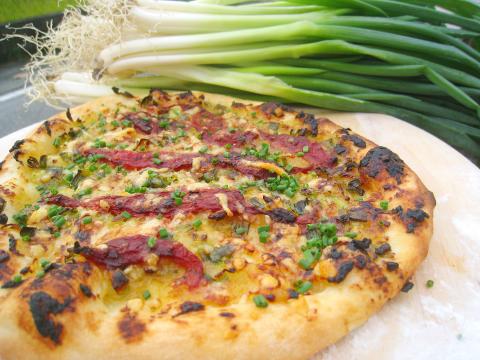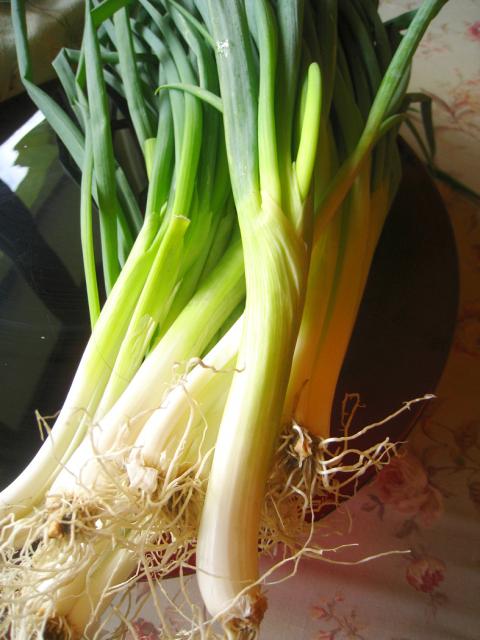The onion that we are probably most familiar with in the West is the bulb onion, also called the common onion. But the allium family is large and diverse, and while the bulb onion has become an integral element in Taiwanese cuisine since its introduction here by a Japanese primary school teacher in Tamsui — so the story goes — in the early part of the 20th century, it has always been scallions, also known as green onions, that have been and remain the main member of the allium family to feature in traditional Chinese gastronomy.
Scallions have white stems that shade into green and do not have any bulb at the base, growing slim and sleek from top to bottom. They are easily confused with their relatives the spring onion, which look very similar for most of their length, but have a small bulb at the base. The confusion is exacerbated by the fact that in many countries that were formerly part of the British empire, such as Australia where I grew up, the scallion is commonly referred to as a spring onion.
Not withstanding this British eccentricity, which put back my understanding of the allium family by decades, it is the scallion that to all intents and purposes is king of the Chinese kitchen.

Photo: Ian Bartholomew
Scallions are bursting forth just now in the vegetable gardens around our house, and vast bundles of the vegetable can be found gracing the stands of local markets. They are vital to the making of good pork dumplings and many other dishes using pork mince, but most famously they are the key ingredient of scallion pancake (蔥油餅), a staple of Chinese breakfast joints, night markets and restaurants specializing in northern Chinese cuisine.
When I saw the long, dense rows of scallions growing in my neighbor’s vegetable garden, making scallion pancakes was my first thought. You can get very good versions of this dish all around Taiwan, but the good ones are vastly outnumbered by inferior versions that are all about dough and not have the refreshingly vibrant flavor that scallions can give to a dish when properly prepared.
Scallions can be eaten raw as part of salads or scatted on top of stir-fries to give the illusion of greenery, wilted in water or oil, grilled, roasted, minced or subjected to just about any other process you can think of. Depending on how you treat them, a bewildering array of flavors can be coxed from them. Which brings me back to the scallion pancake.

Photo: Ian Bartholomew
Scallion pancakes are one of those dishes that seem very simple, and a mediocre version can be put together with relative ease. (There are plenty of recipes online, and while I have found homemade better than frozen commercial varieties, those made by a good specialist hawker or northern Chinese restaurant are in a totally different league.) Really it is no more than an unleavened flatbread laminated with oil and usually with a measly scattering of scallions that provide a little color and just the shadow of scallion flavor to something that usually tastes predominantly of stale deep fry oil.
One version of the scallion pancake, primarily associated with Yilan County, where the area of Sansing (三星) is famous for scallion cultivation, does not roll the scallions into the dough but rather rolls them up and forms a snail from a tube of dough stuffed with scallions, which is then shallow fried until crisp. They yield a really rich scallion eating experience and should be tried if you are able to find a stall shop selling them.
Grilling yields a very different result, and I am rather partial to putting them under the broiler until slightly charred and throwing them over any variety of dishes. This fondness was part of the inspiration for the accompanying recipe of an unconventional onion and bell pepper pizza.
Scallions, like most members of the allium family, can help stimulate immune responses, suppress inflammation and facilitate detoxification. They are low in calories and high in dietary fiber and also contain chemicals that help reduce the risk of cardiovascular disease. There are also plenty of good vitamins and minerals, and scallions are a particularly rich source of Vitamin K, which is vital in promoting bone strength and is said to help prevent Alzheimer’s disease. This is all in addition to their wonderful taste and culinary versatility, so what more is there to say: get yourself a big bunch and go nuts in the kitchen.
It is worth noting that scallions are a renewable resource. They are usually sold with their roots still intact. When you have used the white and green sections, the root section can be replanted in a window box to yield a new batch of scallions for nothing more than the price of a little patience.
Three-onion pizza with roasted bell peppers
(Makes 2 8-inch pizzas)
Tomato-based pizza is the mainstream, so this version, made using an onion puree is a little unusual, and has hints of the scallion pancake without all the oil. I made this pizza using some lean bread dough that I had left over from bread making, but a commercial pizza base should work fine.
Ingredients
1 large brown onion, diced
1 stem of fresh thyme, finely chopped (optional)
8-10 stems scallions, roughly chopped (about 150g)
3 cloves of garlic, thinly sliced
Small bunch of chives, finely chopped
100g grated Grana Padano cheese (parmigiano or pecorino also work well)
1 preserved roasted bell pepper (instructions for making this can be found on page 12 of the Aug. 22 edition of the Taipei Times)
Salt and pepper
Olive oil
Method
1. Warm a tablespoon of olive oil in a pot and add diced brown onions. Cook until turning translucent, add thyme (if using) and cover the pot and cook over low heat until the onions are very soft, about 5 minutes. Remove from heat and blitz into a puree using a blender. Set aside.
2. Warm another tablespoon of olive oil in a pot and wilt the scallions, add the garlic, season lightly with salt and cook until soft, about 3 minutes.
3. Prepare your pizza base. Spread a thin layer of the onion puree on the base, just as you would a tomato sauce. Scatter this topping with a liberal quantity of the scallion and garlic mix.
4. Distribute sections of roasted bell pepper over the top.
5. Sprinkle with cheese.
6. Place on a heavy non-stick baking sheet or slip onto a heated baking stone in an oven pre-heated to its maximum setting (usually around 250c for most home ovens).
7. Cook for 10 minutes. Remove, sprinkle with finely chopped chives and consume while hot.
Ian Bartholomew runs Ian’s Table, a small guesthouse in Hualien. He has lived in Taiwan for many years writing about the food scene and has decided that until you look at farming, you know nothing about the food you eat. He can be contacted at Hualien202@gmail.com.

Oct. 27 to Nov. 2 Over a breakfast of soymilk and fried dough costing less than NT$400, seven officials and engineers agreed on a NT$400 million plan — unaware that it would mark the beginning of Taiwan’s semiconductor empire. It was a cold February morning in 1974. Gathered at the unassuming shop were Economics minister Sun Yun-hsuan (孫運璿), director-general of Transportation and Communications Kao Yu-shu (高玉樹), Industrial Technology Research Institute (ITRI) president Wang Chao-chen (王兆振), Telecommunications Laboratories director Kang Pao-huang (康寶煌), Executive Yuan secretary-general Fei Hua (費驊), director-general of Telecommunications Fang Hsien-chi (方賢齊) and Radio Corporation of America (RCA) Laboratories director Pan
The consensus on the Chinese Nationalist Party (KMT) chair race is that Cheng Li-wun (鄭麗文) ran a populist, ideological back-to-basics campaign and soundly defeated former Taipei mayor Hau Lung-bin (郝龍斌), the candidate backed by the big institutional players. Cheng tapped into a wave of popular enthusiasm within the KMT, while the institutional players’ get-out-the-vote abilities fell flat, suggesting their power has weakened significantly. Yet, a closer look at the race paints a more complicated picture, raising questions about some analysts’ conclusions, including my own. TURNOUT Here is a surprising statistic: Turnout was 130,678, or 39.46 percent of the 331,145 eligible party

The classic warmth of a good old-fashioned izakaya beckons you in, all cozy nooks and dark wood finishes, as tables order a third round and waiters sling tapas-sized bites and assorted — sometimes unidentifiable — skewered meats. But there’s a romantic hush about this Ximending (西門町) hotspot, with cocktails savored, plating elegant and never rushed and daters and diners lit by candlelight and chandelier. Each chair is mismatched and the assorted tables appear to be the fanciest picks from a nearby flea market. A naked sewing mannequin stands in a dimly lit corner, adorned with antique mirrors and draped foliage

The election of Cheng Li-wun (鄭麗文) as chair of the Chinese Nationalist Party (KMT) marked a triumphant return of pride in the “Chinese” in the party name. Cheng wants Taiwanese to be proud to call themselves Chinese again. The unambiguous winner was a return to the KMT ideology that formed in the early 2000s under then chairman Lien Chan (連戰) and president Ma Ying-jeou (馬英九) put into practice as far as he could, until ultimately thwarted by hundreds of thousands of protestors thronging the streets in what became known as the Sunflower movement in 2014. Cheng is an unambiguous Chinese ethnonationalist,